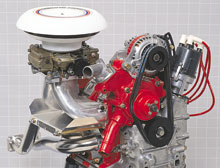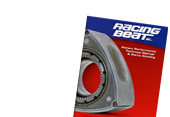Carburetor Applications

Racing Beat-modified Holley Intake Kits for 12A & 13B applications.
Carburetion is a very complex subject, and any discussion here can only deal with generalities. It is also an important subject, since performance, economy, and smoothness are all very much affected by carburetion.
Stock Carburetors
The stock carburetors on early Mazda rotaries are excellent parts, well designed and well built. The only problem is that, for most performance work, they were too small. This shortcoming could be partly offset by increasing the size of the venturis; however, other problems arose in lower RPM street use, such as poor mixture, spark plug fouling, poor throttle response, and poor mileage. However, even though it was possible to improve power using the stock carburetor, replacement parts for these applications are no longer available
Regarding the emission controls that are installed on and around the carburetor: In our experience, the only reason for removing them is simplicity, and the reliability this simplification offers. Neither the valves nor the air pump, if operating properly, has a significant effect on mileage or performance. Many of these parts operate only on deceleration or when the engine is shut off. If you decide that, for simplicity, you wish to remove the air valves and the air pump, we recommend the following:
On 1975 and earlier 12A engines, either replace the stock air nozzles with blocking nozzles or cut off the top .125-inch of the stock air nozzles, weld the end shut, and re-install them. On all models, retain the fuel tank vent hose (on most models, it enters the top of the air cleaner) as well as some form of crankcase breather from either the air/oil separator (located on the oil filler neck) or the short tube just below it on the intermediate housing. Other than this, just cap off, cover, or block any other openings you uncover. We offer various blocking plates to cover the opening that remains in the stock intake manifold when the Air Control and Check Valve unit is removed.
Replacement Carburetors - Holley
For certain applications, our Racing Beat-modified Holley Intake Systems are a very popular choice. These "streetable" intake systems have been developed and tuned by Racing Beat as a complete kit and include a Racing Beat-modified Holley carb, and complete installation instructions and mounting hardware. The Holley 465 CFM carbureter that we use in several of our systems feature a temperature activated choke for improved cold weather starting performance.
Each Racing Beat kit has been tuned for a very specific engine application, and should only be used for that recommended engine. Each Holley carburetor that we offer is completely disassembled, various components machined, jets retuned, and then reassembled. Attempting to use a kit on another engine application might be possible, but you would need to undertake your own research and retune the carburetor for this application.
Replacement Carburetors - Weber
The alternatives we offer for the Holley system are the Weber 48 or 51 IDA two-barrel downdraft carburetors. These carburetors are useful for racing and certain other specialized applications primarily because of their simplicity, compactness, and excellent float bowl design.
As applied to a Mazda rotary, Weber carburetors exhibit a variety of positive and negative characteristics. On a stock or street ported engine, the lack of a choke system on these units makes cold starts difficult. However, for some applications, such as off-road, boats, racing, etc., these problems may not be significant. If this carburetor is used on a bridge ported engine, the only problem is lack of sufficient power, partly because it is too small, and partly because of intake losses.
Our testing has shown that maximum power from a bridge ported 12A engine with a Weber 48 IDA carburetor is about 250 HP, while a suitable Holley carburetor on the same engine can produce over 250 HP. The one application where the Weber 48 IDA carburetor is still used is on peripheral port engines. Here, its relatively small size is compensated by the excellent breathing capability of the porting. Nevertheless, we have found that, by enlarging the carburetor to 51mm diameter (from 48mm diameter), approximately 10 HP more is available. 12A peripheral engines can develop 280+ HP with a Weber 51 mm carburetor.
Intake Manifolds
Racing Beat offers a wide range of cast aluminum manifolds for both Holley and Weber applications. All Racing Beat manifolds were designed and tested by Racing Beat's co-founder Jim Mederer. Subjected to 1000's of hours of testing and use over the years on our in-house engine dyno, these manifolds and have been sucessfully used on both street and racing applications for decades. Each manifold is cast at a local casting shop, flycut, machined, hand-ported to match both the inlet and outlet gaskets, and finished in our ball-burnishing tank to provide a semi-shine appearance. If you wish to undertake further porting of your manifold we offer porting tools and materials for use with your air grinding equipment.
Copyright 2007-2024 Racing Beat, Inc ©




